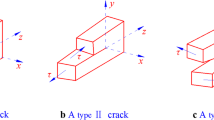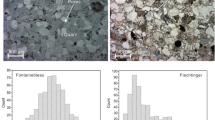Abstract:
In our previous paper (Eur. Phys. J. E 4, 121 (2001)) we proposed a coarse-grained elastic energy for nacre, or stratified structure of hard and soft layers found in certain seashells . We then analyzed a crack running perpendicular to the layers and suggested one possible reason for the enhanced toughness of this substance. In the present paper, we consider a crack running parallel to the layers. We propose a new term added to the previous elastic energy, which is associated with the bending of layers. We show that there are two regimes for the parallel-fracture solution of this elastic energy; near the fracture tip the deformation field is governed by a parabolic differential equation while the field away from the tip follows the usual elliptic equation. Analytical results show that the fracture tip is lenticular, as suggested in a paper on a smectic liquid crystal (P.G. de Gennes, Europhys. Lett. 13, 709 (1990)). On the contrary, away from the tip, the stress and deformation distribution recover the usual singular behaviors ( and 1/, respectively, where x is the distance from the tip). This indicates there is no enhancement in toughness in the case of parallel fracture.
Similar content being viewed by others
Author information
Authors and Affiliations
Additional information
Received 16 November 2001
Rights and permissions
About this article
Cite this article
Okumura, K. Why is nacre strong? II. Remaining mechanical weakness for cracks propagating along the sheets. Eur. Phys. J. E 7, 303–310 (2002). https://doi.org/10.1140/epje/i2001-10096-4
Published:
Issue Date:
DOI: https://doi.org/10.1140/epje/i2001-10096-4




